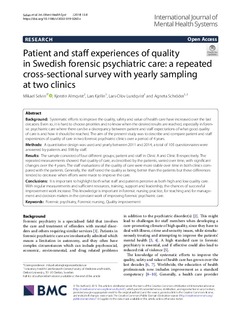| dc.contributor.author | Selvin, Mikael | |
| dc.contributor.author | Almqvist, Kjerstin | |
| dc.contributor.author | Kjellin, Lars | |
| dc.contributor.author | Lundqvist, Lars-Olov | |
| dc.contributor.author | Schröder, Agneta | |
| dc.date.accessioned | 2019-10-03T08:02:15Z | |
| dc.date.available | 2019-10-03T08:02:15Z | |
| dc.date.created | 2019-05-23T17:12:56Z | |
| dc.date.issued | 2019 | |
| dc.identifier.citation | International Journal of Mental Health Systems. 2019, 13 (8), 1-9. | nb_NO |
| dc.identifier.issn | 1752-4458 | |
| dc.identifier.uri | http://hdl.handle.net/11250/2619962 | |
| dc.description.abstract | Background
Systematic efforts to improve the quality, safety and value of health care have increased over the last decades. Even so, it is hard to choose priorities and to know when the desired results are reached, especially in forensic psychiatric care where there can be a discrepancy between patient and staff expectations of what good quality of care is and how it should be reached. The aim of the present study was to describe and compare patient and staff experiences of quality of care in two forensic psychiatric clinics over a period of 4 years.
Methods
A quantitative design was used and yearly between 2011 and 2014, a total of 105 questionnaires were answered by patients and 598 by staff.
Results
The sample consisted of four different groups; patient and staff in Clinic A and Clinic B respectively. The repeated measurements showed that quality of care, as described by the patients, varied over time, with significant changes over the 4 years. The staff evaluations of the quality of care were more stable over time in both clinics compared with the patients. Generally, the staff rated the quality as being better than the patients but these differences tended to decrease when efforts were made to improve the care.
Conclusions
It is important to highlight both what staff and patients perceive as both high and low quality care. With regular measurements and sufficient resources, training, support and leadership, the chances of successful improvement work increase. This knowledge is important in forensic nursing practice, for teaching and for management and decision makers in the constant work of improving forensic psychiatric care. | nb_NO |
| dc.language.iso | eng | nb_NO |
| dc.publisher | BioMed Central | nb_NO |
| dc.rights | Navngivelse 4.0 Internasjonal | * |
| dc.rights.uri | http://creativecommons.org/licenses/by/4.0/deed.no | * |
| dc.title | Patient and staff experiences of quality in Swedish forensic psychiatric care: a repeated cross-sectional survey with yearly sampling at two clinics | nb_NO |
| dc.type | Journal article | nb_NO |
| dc.type | Peer reviewed | nb_NO |
| dc.description.version | publishedVersion | nb_NO |
| dc.source.pagenumber | 1-9 | nb_NO |
| dc.source.volume | 13 | nb_NO |
| dc.source.journal | International Journal of Mental Health Systems | nb_NO |
| dc.source.issue | 8 | nb_NO |
| dc.identifier.doi | 10.1186/s13033-019-0265-z | |
| dc.identifier.cristin | 1699893 | |
| dc.description.localcode | Open Access This article is distributed under the terms of the Creative Commons Attribution 4.0 International License (http://creativecommons.org/licenses/by/4.0/), which permits unrestricted use, distribution, and reproduction in any medium, provided you give appropriate credit to the original author(s) and the source, provide a link to the Creative Commons license, and indicate if changes were made. | nb_NO |
| cristin.unitcode | 194,65,20,0 | |
| cristin.unitname | Institutt for samfunnsmedisin og sykepleie | |
| cristin.ispublished | true | |
| cristin.fulltext | original | |
| cristin.qualitycode | 1 | |

